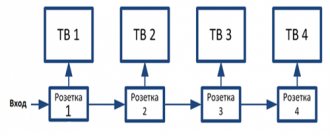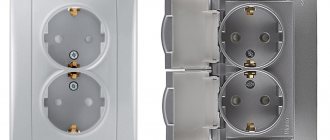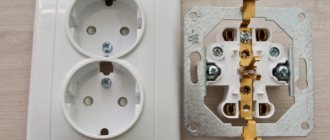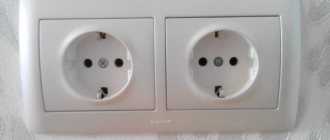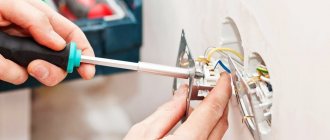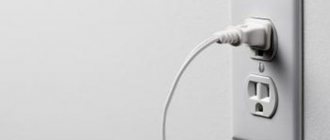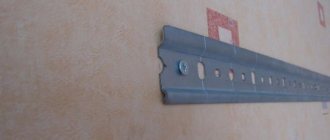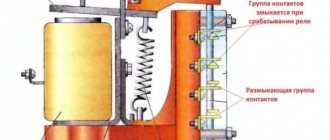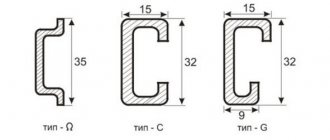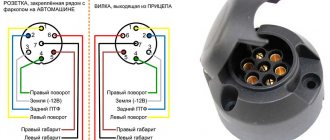A DIN rail socket is a device in the form of a monoblock plug connector with standardized grips for a DIN rail for installation in a distribution panel.
This product, in its design and functional features, resembles a conventional electrical socket with a width between contacts according to the Euro standard.
The only significant difference is that it is designed to connect lighting and other electrical equipment directly to the electrical panel. A regular outlet cannot be installed in such places.
Main purpose
The electrical panel consists of a number of modular devices (switches, automatic machines, indicators, sockets, etc.), each of which performs a specific function.
The panel socket is mounted in an electrical panel to allow connection of any electrical appliance to it during maintenance and repair of switchgear elements. Such an outlet is often used to connect electricity consumers located close to the switchboard. Often, during a control inspection of equipment, portable lamps are also connected.
The DIN rail socket is installed in buildings of various enterprises and office premises of large companies to create reliable electrical contact with the power plug of a device of any power during the arrangement of mock-up pavilions, test benches, etc.
How to connect a switch from an outlet, how to make an outlet from a switch
The development of an indoor electrical network can be planned both during its initial design and during the operation of ready-made wiring. In any case, you want to connect distribution boxes, mounted socket boxes, and switches with each other with minimal material costs.
Disconnection of the power cable is not necessarily carried out exclusively in installation boxes, which are hub splitters. For example, there are many ways to connect a switch to an outlet, and vice versa. Some of the switching can be done in any box, the main thing is that there is no danger of shorting the contacts.
A typical example of combining a socket and a switch in one unit
Often in a corridor or hallway there is a need to combine a network connection point (socket) and a switch for several lighting groups. This method solves several problems:
- An extensive electrical outlet network in the corridor is usually not needed: there are no constantly used electrical appliances. However, there is a need to connect a vacuum cleaner or charger. In addition, a radiotelephone base unit can be installed in the hallway.
- There is little space on the walls in this room; there are wardrobes, a mirror, and a hanger. Part of the corridor is usually occupied by the input switchboard and metering device (meter). Therefore, compact placement of switching equipment is a key issue.
- By combining the socket and switch, wiring is saved and installation of an additional junction box is not required.
- If you additionally connect a second device: a switch to a socket, or vice versa, there is no need to damage the wall or organize a route for the power cable. The connection is made with minimal impact on the room.
Types of DIN rails
DIN rail is a special metal profile (steel, AL, Cu), which is used as a generally accepted fastening device for installation and dismantling (if necessary) of plug sockets, electric meters, differentiated machines, circuit breakers and other electrical devices.
The rail was named DIN in honor of the German Institute for Standardization, where it was developed. This generalized standard is a basic document that is referenced in the manufacture of electrical devices in almost all countries of the world.
DIN rails are standardized in size and have holes or notches for fastening the product or dividing it to obtain a certain length.
Reiki are classified into the following types:
- Rack type Ω. This is a frequently used fastening structure, resembling the letter Ω in a side section. Many modular devices, including panel sockets, are mounted on a TN 35 rail, where 35 mm is the width of the rail strip. To fasten the terminals, similar strips of reduced overall dimensions are used.
- Rail type C. Products in this category are C-shaped. They are widely used for fastening electrical installation products intended for connecting wires (terminal blocks).
- Rail type G. The profile of this product resembles the letter G in appearance. The main area of application is fastening hardware clamps.
Sockets on slats
Voltmeter D2-V-1-0.5 AC with DIN rail mounting
There are several most commonly used types of devices designed for installation on a DIN rail. They differ in size and the presence of grounding contacts. The main distinctive feature of modular sockets is the presence of terminals that serve for attachment to an additional profile.
The socket without grounding has small dimensions, its width is 1.75 cm, which is equal to 1 module. Its main purpose is to connect low-power devices that do not require grounding (soldering iron, small lamp). The rated current value is 6A or 10A.
The grounded socket is 2.5 modules wide. This is due to the presence of grounding contacts inside the housing. The device is intended for connecting devices whose metal elements require grounding during operation. The rated current of this type of outlet is identical to the previous type of device.
The structural dimensions of the electrical device meet international standards, which allows them to be installed in modern electrical panels without the use of auxiliary fasteners and are with or without grounding:
- distance between edges: 7.6 cm and 7.7 cm;
- length: with grounding – 4.4 cm and 1.8 cm;
- plug connector height: regardless of type – 4.5 cm;
- thickness: 6.4 cm and 6.6 cm.
DIN rail socket with grounding contact
Design and characteristics
A special feature of the internal structure of panel sockets on a DIN rail is a plastic latch, thanks to which the device is securely attached to an additional profile - the rail.
There are several types of modular sockets:
- No grounding. Small in size, 17.5 mm wide, which means they take up the space of 1 standard module in the panel. This is their main advantage. Used to connect electrical appliances that do not require grounding and low power: soldering irons, lamps, etc. Rated current 6A, 10A.
- With grounding. Their width is much larger than ungrounded ones, amounting to 2.5 modules. Due to the fact that such sockets are equipped with grounding contacts, their use extends to connecting devices with metal components that require grounding. The current parameter is 10A and 6A.
Attention! Powerful electrical appliances cannot be connected to an outlet without grounding!
Modular sockets are divided according to the degree of protection from harmful factors such as moisture and dust. The value is indicated in alphanumeric form. For example, the code is IP44, where IP is the level of protection against the penetration of foreign elements of any size into the device’s body, and 44 is the degree of its moisture protection.
Note! If a DIB socket is installed in a residential switchboard, then it is sufficient that its protection level is at least IP20. If the device is located in unfavorable conditions - on the street, in a smoky or damp room, then the degree of protection of the device must be at least IP44.
The dimensions of modular sockets are set by the world standard and are in the following range:
- length (with ground): 44 mm, 18 mm;
- height (with or without grounding): 45 mm;
- distance between edges: 76 mm, 77 mm;
- thickness: 64 mm, 66 mm.
Blitz tips
- The use of standardized rails in electrical panels greatly facilitates their maintenance. To replace the device, you just need to loosen the fastening elements of the wires on the clamps to disconnect them, then the latch is moved down and the device is removed from the rail.
- To determine the value of direct current of equipment , it is necessary to divide its power by the network voltage.
- If you plan to connect powerful electrical appliances to the distribution center , experts recommend using socket models with a rated current of at least 16A.
- To install sockets in distribution nodes, it is enough to use a device with a degree of protection of at least IP. When installing a DIN rail outdoors or in rooms with high humidity, it is recommended to ensure a protection level of at least IP44.
Installation
Before you begin installing an electrical socket, you need to make sure that the parameters of the socket correspond to the power of the equipment that is intended to be connected.
If the socket is installed on a small electrical panel of a house or apartment, then the rated current is quite acceptable 6A, 10A. If a modular device is installed to power powerful electrical appliances required when performing construction or repair work, then its rated current must be at least 16A.
As an example, let's take a Bemis 1/16A grounded electrical socket with a degree of protection IP44. The durable plastic case corresponds to a high level of protection, which makes it possible to use Bemis 1/16A in production.
Sequence of installation of a modular electrical socket:
- Using a screwdriver, pry up the movable part of the plastic clip.
- Place the socket on the rail profile and release the clamp. A click indicates that the latch is secured, which means the socket is locked.
- Start connecting three wires to it: phase, neutral and ground.
Features of installing a modular socket
Before installing each electrical panel, it is necessary to clearly determine the number and order of arrangement of all modular devices included in its composition. This is connected not only with the need to correctly draw up the general power supply diagram for the apartment, but also directly affects the choice of the switchgear housing.
Each modular element has a clearly defined size, which is regulated by the DIN43880 standard. In accordance with this document, the width of one module is taken to be 17.5 mm.
Depending on the power, today two types of DIN rail sockets are produced. They differ primarily in size.
The design of each such outlet is not fundamentally different from the design of built-in or surface-mounted models. This socket also has two working terminals, to which the phase and neutral wires are connected. Depending on the purpose, this device may be equipped with grounding contacts.
The only feature of such sockets is their clearly regulated shape and size, as well as the presence of a special latch that allows the product to be mounted on a rail.
The figure shows the two most common types of sockets designed for installation on a DIN rail. These models, in addition to their size, are distinguished by the presence of grounding contacts.
Socket without grounding
The width of this device is 1 module (17.5 mm), it is very compact. To install such an outlet you do not have to allocate a lot of space. A similar product is intended for connecting low-power consumers that do not require mandatory grounding, for example, a lamp or soldering iron. Models with rated current of 6 and 10 A are available.
Grounded socket
The socket is somewhat larger, having a width of 2.5 modules. It is equipped with grounding contacts and is intended to supply power to consumers whose metal parts of the housing must be grounded during operation. Such devices include, for example, hand-held power tools. Models are available with a rated current of 10 and 16 A.
The main parameters that characterize such sockets are the rated voltage and current, as well as the degree of protection.
Within the two varieties considered, there are a fairly large number of design options for sockets designed for installation on a DIN rail, which are designed to work in different conditions.
Most devices presented in electrical goods stores have a degree of protection of IP20, which is quite enough for installing them in a distribution panel.
As for decoding the designation of the degree of protection of electrical equipment IP, it is very simple. The first digit of the code corresponds to the diameter of the object from which this equipment is protected. The number 2 means that the device body is protected from penetration by objects with a diameter of more than 12.5 mm (human fingers or similar objects). The second digit of the numerical code indicates the degree of moisture protection. 0 corresponds to the absence of any protection against moisture.
If necessary, you can select a product that meets higher protection standards. For example, the Bemis 1/16A grounded socket, which has an IP44 degree of environmental protection, is designed for use in difficult conditions. The body of this product is made of durable plastic and is reliably protected from dust and water splashes. This makes it possible to actively use such sockets in manufacturing enterprises.
The panel socket is attached to the DIN rail very simply. To do this, you just need to pull out the lower movable clamp and install the socket on the rail until the lock clicks into place. After this, all that remains is to connect the phase and neutral wires to its terminals.
Connecting wires
The connection of the panel socket can be carried out before or after installation. If the first option is chosen, then you need to pay attention to the length of the wires: their length should be enough to carry out the work related to the connection.
To make the connection, you will need clamps for connecting electrical wires.
Note! The cross-sectional diameter of the electrical wires must not be less than the value indicated on the housing.
The wires can be connected in any order, the main thing is not to confuse the phase and neutral wires.
The wire responsible for grounding, depending on the electrical circuits, can be connected in two ways: to the body of the switchboard cabinet or with specially provided separate clamps.
Types of terminal blocks
What does a typical terminal block consist of? If you think that the simplest feed-through terminals are enough to complete it, then you are deeply mistaken.
Today, two types of terminal blocks have become widespread:
- screw
- spring
The article will discuss in detail exactly those that are screw-mounted. They are more universal and can be used to clamp anything - single-core and stranded wires, wires pressed under the tip.
They have two numbers in their designation.
- the first digit indicates the maximum possible cross-section of the conductor for connection
- the second is the width of the pad in millimeters
One standard din module in the shield takes up 17.5mm. It just fits one machine gun. At the same time, this same module will easily fit three MA 2.5/5 terminals or other similar models.
The current for which the terminal is designed is written on the housing.
Even the familiar feed-through terminals can be of different types:
- firstly, for wires of different sections 2.5-4-6-10mm2, etc.
There are power models up to 240-270mm2.
- with switch (knife switch)
With a slight movement of a screwdriver, the circuit can be opened without unscrewing the screw terminals.
This can be convenient when during operation it is necessary to change the electrical circuit by disconnecting any circuits. Or you quickly need to find the damaged cable.
Throw back all the chains one by one and call the wires.
- with diodes
- with fuses
They are used to protect low-current networks of control, monitoring and measurement lines with low currents.
- double-row
- two, three, four wire
From one terminal and one seat in the shield, you can immediately connect two contacts on a button or feed both phase and zero through it.
However, there is one significant drawback here. Most of these products have a fairly decent height. And if you plan to use it to save space in your dashboard, then you won’t be able to neatly hide it under a plastic cover.
It will stick out almost at the same level as the machine gun. You will have to put up with this. Or look for more expensive options.
- current
The current terminals inside have a special element with which, without disconnecting the wires, you can also break the circuit.
Some models are equipped with test connectors into which standard plugs from devices are plugged.
Thus, again without unscrewing the wires, all necessary measurements and tests can be carried out. It’s also easy to short-circuit current circuits through them to quickly replace an ammeter or meter, without removing the outgoing feeder line for repair.
In Soviet times, installers used ordinary crocodiles for this. You hook them onto the exposed parts and move on.
However, such a contact could come off spontaneously at the most inopportune moment. Now everything is more thoughtful, neater and safer.
One listing of all variations and types of terminal blocks can take more than one page. Therefore, we will dwell in more detail on the most important points, the most popular models, with which an electrician most often has to deal in his daily work.
Popular manufacturers
Many retail outlets offer a chic assortment of electrical devices, including sockets. Having set out to purchase a high-quality socket on a DIN rail, the question arises: what to choose?
Let us note a number of brands that occupy a leading position in the market of electrical goods manufacturers:
- French company Legrand. For more than 100 years, it has been manufacturing information and electrical products.
- A large French engineering company, Schneider Electric, which has an excellent reputation as a manufacturer of equipment for the distribution and transmission of electricity.
- The Swedish-Swiss company ABB, which produces automatic protective equipment for electrical networks for various purposes. It is recognized that ABB is the leading manufacturer of such products on the CIS market.
- Italian company Bticino, which produces electrical goods of the highest quality.
The only disadvantage of all the listed manufacturers is their high pricing policy. For those looking for a budget option for electrical goods, the following list of brands is recommended:
- Makel;
- TDM Electric;
- Anam;
- Lezard;
- Wessen;
- GUSI.
These manufacturers produce high-quality electrical products at affordable prices. Thus, when buying a DIN rail socket, you will not incur any special costs, but will be able to ensure ease of maintenance and repair of the electrical equipment of the switchgear.
